NVIDIA GeForce GTX 760 Review: The New Enthusiast Kepler
by Ryan Smith on June 25, 2013 9:00 AM ESTOverclocking GTX 760
Like the GTX 770 last month, the GTX 760 is clocked relatively high. Its 980MHz base clock is 65MHz higher than either the GTX 670 or GTX 660 Ti. As a result some of the overclocking headroom that we would expect has been eaten into by the overclock. Yet on the other hand the higher voltage for the highest boost bin – 1.2v versus 1.175v – gives us some additional overclocking headroom as long as our cooling can keep up.
At the same time the GTX 760 gets a slightly larger TDP adjustment window than most other GK104 parts. Here we can push the TDP up by up to 15%, from 170W to 195W. This is actually more than the GTX 770, so in TDP limited scenarios we should have a slightly easier time hitting the higher boost bins.
| GeForce GTX 760 Overclocking | ||||
| Stock | Overclocked | |||
| Core Clock | 980MHz | 1130MHz | ||
| Boost Clock | 1033MHz | 1183MHz | ||
| Max Boost Clock | 1149MHz | 1306MHz | ||
| Memory Clock | 6GHz | 6.5GHz | ||
| Max Voltage | 1.2 | 1.212v | ||
In practice GTX 760 ended up exceeding our expectations. In fact it even ended up exceeding GTX 770 with regard to the size of the overclock and the highest boost bin we reached. Altogether we were able to increase the core clock by 150MHz on our GTX 760 sample, going from a base clock of 980MHz to 1130MHz. At the same time our max boost clock went from 1149MHz to 1306MHz, making this the first Kepler we’ve seen to surpass 1300MHz. The end result is that core overclocking ends up being more potent than we were expecting.
Meanwhile the memory overclock is fairly standard for a GK104 part. It’s something of a roll of the dice, and in this case we were able to hit 6.5GHz before memory performance started regressing. Thus we’re altogether looking at a 15% core overclock coupled with a milder 8% memory overclock.
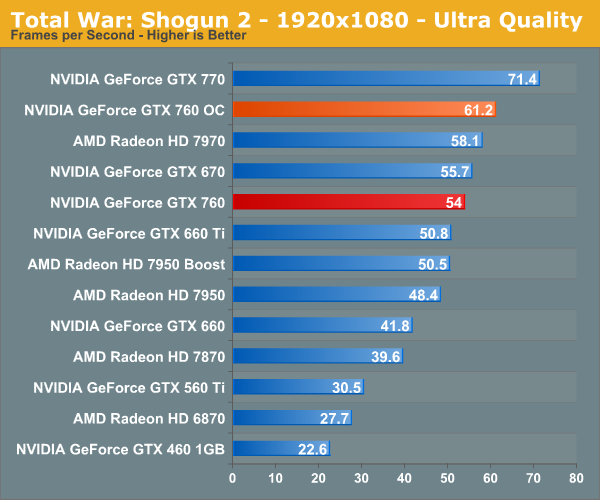
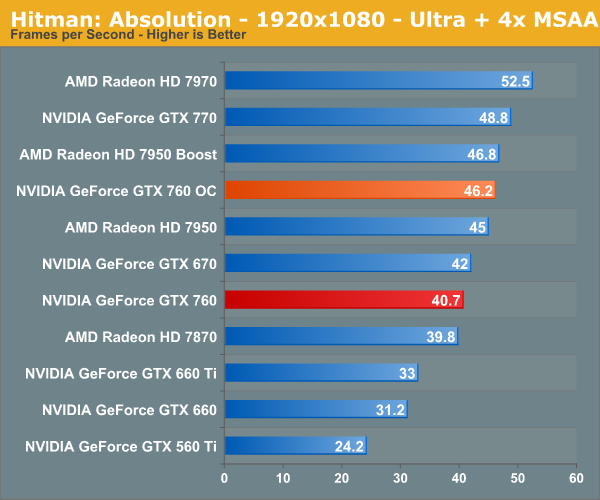
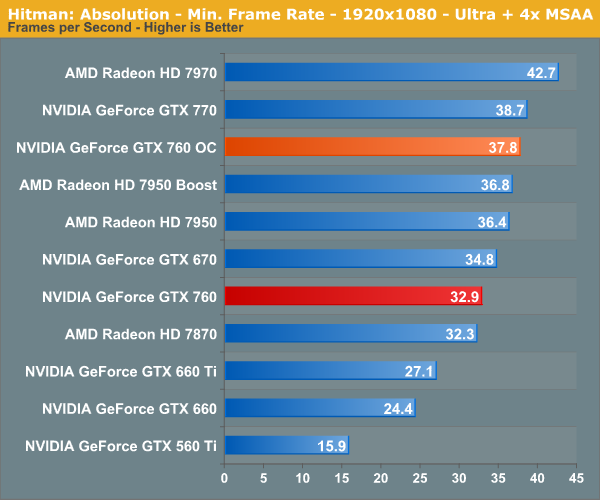
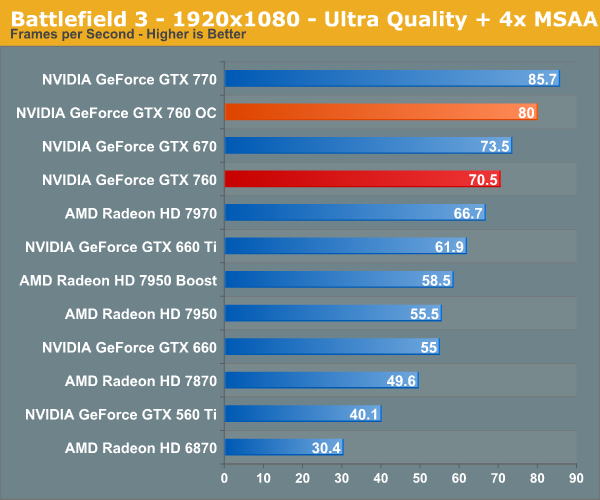
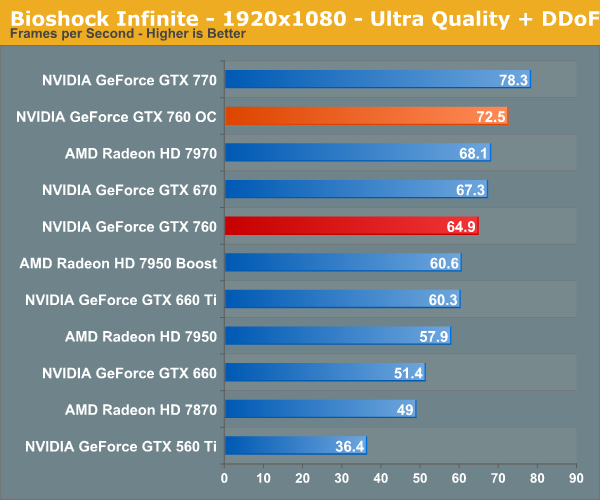
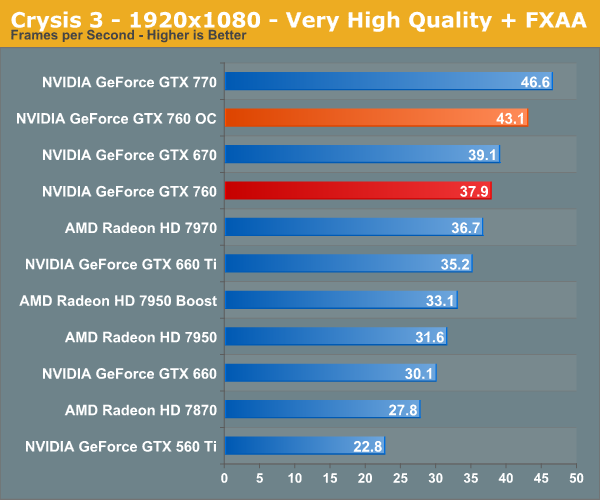
Given GTX 760’s base shader/texture performance deficit due to only having 6 SMXes, overclocking proves to be very effective on our final results. The performance gains in all 5 of our games were on the order of 12% to 14%, just a bit less than the core overclock itself. With the wide gap between the GTX 770 and GTX 760 in terms of specs this generally isn’t enough to completely catch up to NVIDIA’s top-tier GK104 card, but it can erase a large portion of the gap.
The end result of this overclock won’t dramatically change the GTX 760’s performance profile, but it should help to push it over 60fps in those situations where performance at 1080p at ultra quality settings was marginal. Or from a fixed performance standpoint, we’re approaching Radeon HD 7970 performance with this overclock.
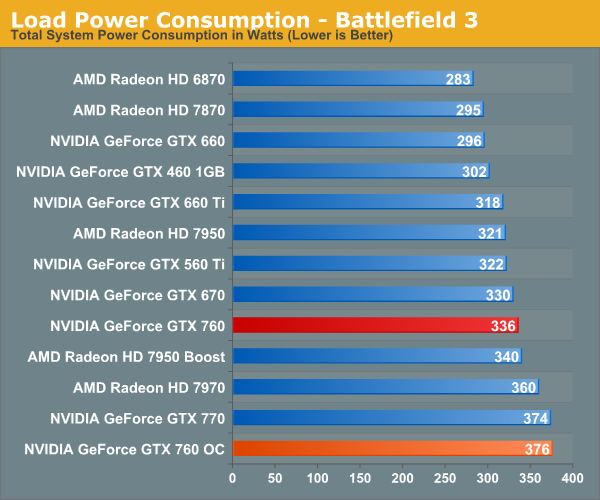
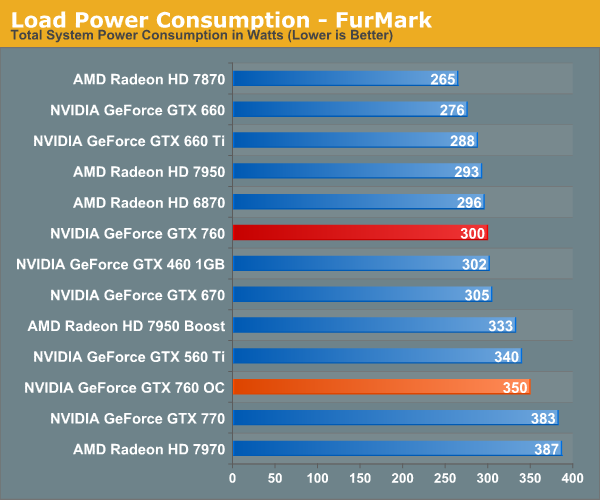
Moving on to power consumption, increasing our TDP has the expected hit. GTX 760 of course has a larger adjustment window than GTX 770, so the increase in power consumption ends up being noticeably larger. Overclocking in this manner pushes the GTX 760 off of the power/performance efficiency curve to some degree, so the GTX 760 loses its edge in that respect.
The end result is that power consumption at the wall jumps by 40W under BF3, and 50W under FurMark. This is tied with and better than the stock GTX 770 respectively, though as we’ve already seen it doesn’t match the GTX 770’s rendering performance. Furthermore as we’ll see, cooling is going to play a big factor here, with the reference GTX 760 cooler not always being the best choice for overclocking.
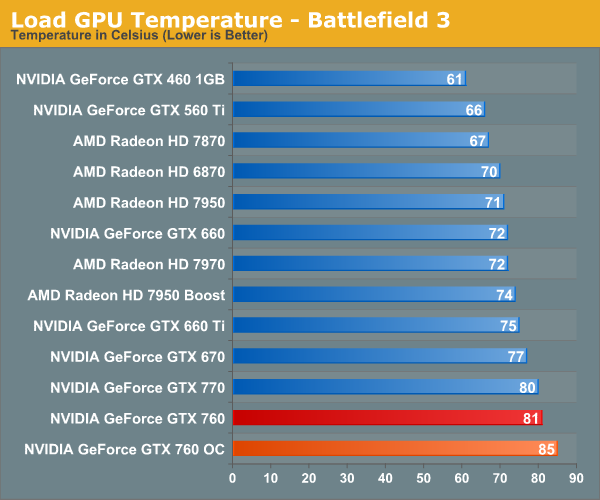
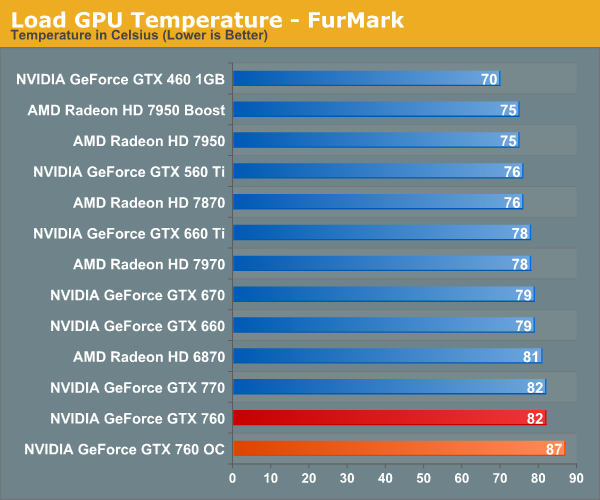
With the temperature limit raised to 95C, the reference GTX 760 cooler reaches equilibrium at 85C under BF3 and 87C under FurMark. These temperatures are still easily within spec for GK104, but they’re definitely starting to crawl up here. Meanwhile, though it’s not directly measurable the impact of leakage is certainly making itself felt here. If we had cooler temperatures power consumption would at least be marginally lower.
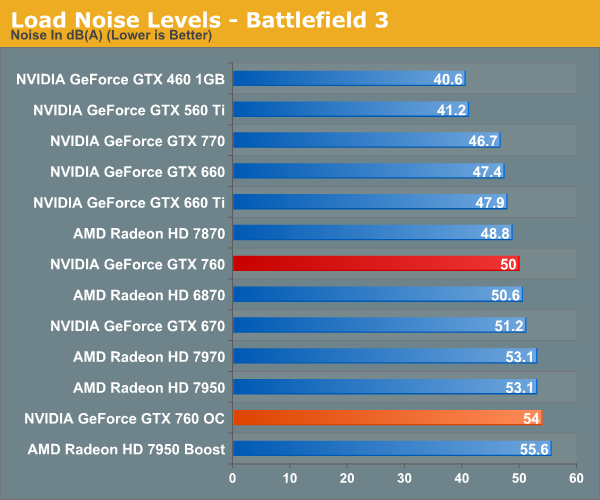
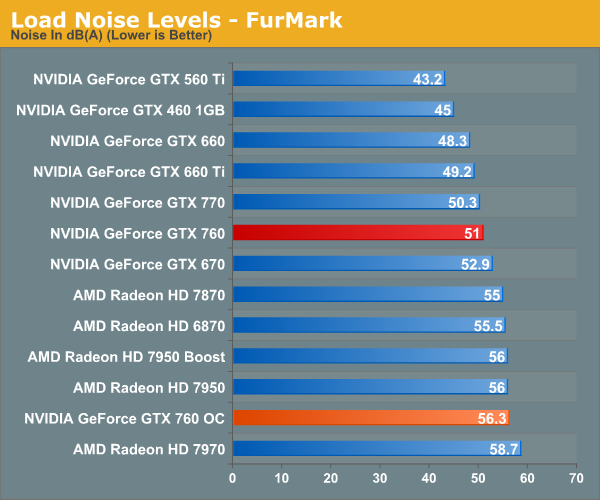
Finally we noise we can see that those new equilibriums also come at new, much higher noise levels. The reference cooler can keep up with the higher heat load created by overclocking, but it’s having to work hard to do so. These noise levels aren’t terrible – in fact they’re about even with the reference 7950 – but they do represent a real cost in terms of noise. Consequently, unlike NVIDIA’s Titan cooler that comes with the reference Titan, GTX 780, and GTX 770, when it comes to GTX 760 there’s very clearly room for improvement with custom coolers.










110 Comments
View All Comments
Impulses - Thursday, June 27, 2013 - link
Hmm, it took a while but it seems like I finally have a suitable upgrade path from my CF 6950x2 (unlocked)... I paid about $225 for each of those and I just haven't seen a card (or a pair of cards) that would be a substantial enough upgrade for under $500. SLI GTX 760 is more than I was hoping for, when the 770 came in at $400 I almost expected this to come in at $300+.Now, the question is, will I be bottlenecking myself under future games with 2GB GTX 760s in SLI for gaming at 5760x1200 or 3600x1920? My 6950s have held up well but I've been playing a lot of older games too... Should I be looking at a single GTX 780 instead or something?
mapesdhs - Monday, July 1, 2013 - link
As is so often the case, that depends on the games you're playing, and whether you're
using any mods, etc. Heavily modded Skyrim definitely needs more than 2GB even with
one high-res display. Heavy AA also needs more VRAM. Personally, if I was going for
multi-screen gaming, I'd want more than 2GB. Others have mentioned a 4GB 760, so
maybe that's an option? Or of course there are the various 3GB AMD cards, though I
wouldn't bother with CF until AMD's new drivers are out.
Some advantages of getting a single 780: better upgrade path in the future, less
power consumption, no SLI issues. The down side of course is the cost.
Ian.
hasseb64 - Thursday, June 27, 2013 - link
headline:"The new Enthusiast kepler"
Enthusiast?
Ever heard about "Main stream"?
I have nothing more to say!
tynopik - Thursday, June 27, 2013 - link
typo: 'less than idea for an action game' -> idealFar Cry 3 page
sdgvtree - Saturday, June 29, 2013 - link
nput this URL:==== [www.shun-happlymall.com] ====
you can find many cheap and fashion stuff
dineshramdin - Tuesday, July 2, 2013 - link
The most attractive feature is the 256 bit bus that would enable you a huge bandwidth and you can deal with any sort of resolutions if necessary. and for laptop accessories and many more, check this out- http://tinyurl.com/neqrzr9
Buddhaz Priest - Friday, July 12, 2013 - link
Wow. initially I kind of panned the GTX 770 because I didn't feel it was enough of a jump from the 670 for the price difference. Seemed like it wasn't a big hardware jump and that you were paying for the software goodies like GPU Boost 2.0, but after seeing the number difference between the 670 and 770 I gotta say I'm pleasantly surprised with how well the 770 performs.BadThad - Friday, June 13, 2014 - link
Let's see, no mention of the R270? You can find them for $150-175 (cheaper than the GTX) and they are virtually the same as far as performance.j18kuhn - Thursday, January 22, 2015 - link
I got one at best buy for my first pc for 210 and now I'm waiting on the rest of my parts from amazonArtas1984 - Sunday, August 16, 2015 - link
Seeing how the new GTX960 is just slightly ahead of GTX760, i guess buying the GTX760 was a smart choice. The gap between GTX970 and GTX960 is MASSIVE.